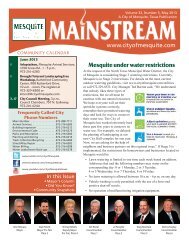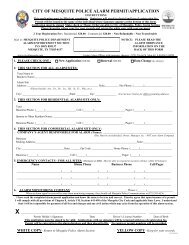airport/documents/Mesquite Master Plan Final.pdf - The City of ...
airport/documents/Mesquite Master Plan Final.pdf - The City of ...
airport/documents/Mesquite Master Plan Final.pdf - The City of ...
Create successful ePaper yourself
Turn your PDF publications into a flip-book with our unique Google optimized e-Paper software.
provides direction on runway length for<br />
aircraft operating at 90 percent useful<br />
load.<br />
Paragraph 306 <strong>of</strong> the AC recognizes<br />
that general aviation <strong>airport</strong>s are being<br />
used more frequently by business jets.<br />
General aviation (GA) <strong>airport</strong>s “that<br />
receive regular use by large airplanes<br />
over 12,500 pounds, in addition to<br />
business jets, should provide a runway<br />
length comparable to non-GA <strong>airport</strong>s.<br />
That is, the extension <strong>of</strong> an existing<br />
runway can be justified at an existing<br />
GA <strong>airport</strong> that has a need to<br />
accommodate heavier airplanes on a<br />
frequent basis.” This is the exact<br />
3-16<br />
scenario that is currently taking place<br />
at <strong>Mesquite</strong> Metro Airport, and thus,<br />
needs to be planned for.<br />
<strong>The</strong> top half <strong>of</strong> Table 3H presents the<br />
list <strong>of</strong> those aircraft which make up the<br />
75 percent <strong>of</strong> the active business jet<br />
fleet category. <strong>The</strong> bottom half,<br />
presented in Table 3H, represents the<br />
aircraft used for the 100 percent<br />
category in Table 3G. Those aircraft<br />
that fall in the remaining 25 percent,<br />
make up 100 percent <strong>of</strong> the active<br />
business jet category, utilize the <strong>airport</strong><br />
on an infrequent basis, but are likely to<br />
use the <strong>airport</strong> more frequently in the<br />
short term.<br />
TABLE 3H<br />
Aircraft Type as a Percent <strong>of</strong> the Business Jet Fleet<br />
<strong>Mesquite</strong> Metro Airport<br />
Manufacturer Models<br />
Airplanes that make up 75 percent <strong>of</strong> the fleet per Table 3G<br />
Beech Jet 400<br />
Cessna 500, 525A, 550, 560, 650 (Citation VII)<br />
Dessault Falcon 10, 20, 50, 200<br />
Hawker 400, 600<br />
IAI Jet Commander 1121, Westwind 1123/1124<br />
Learjet 20, 31, 35, 36, 45<br />
Mitsubishi 300<br />
Sabreliner 40, 60, 75a/80, T-39<br />
Bae 125-700<br />
Raytheon 390 Premier<br />
Aerospatiale Sn-601 Corvette<br />
Airplanes that make up 100 percent <strong>of</strong> the fleet per Table 3G<br />
Bombardier Challenger 600, 601, 604<br />
Cessna 650 (Citation III/VI), 750<br />
Dessault Falcon 900, 900EX, 2000<br />
IAI Astra 1125, Galaxy 1126<br />
Learjet 55, 60<br />
Hawker 800, 800EX, 1000<br />
Sabreliner 65, 75<br />
Source: FAA AC 150/5325-4B<br />
Since it is known that most <strong>of</strong> the<br />
aircraft listed in the 100 percent <strong>of</strong> the<br />
business jet category utilize the<br />
<strong>Mesquite</strong> Metro Airport, consideration<br />
should be given to providing adequate<br />
runway length for their safe and<br />
efficient operation.




